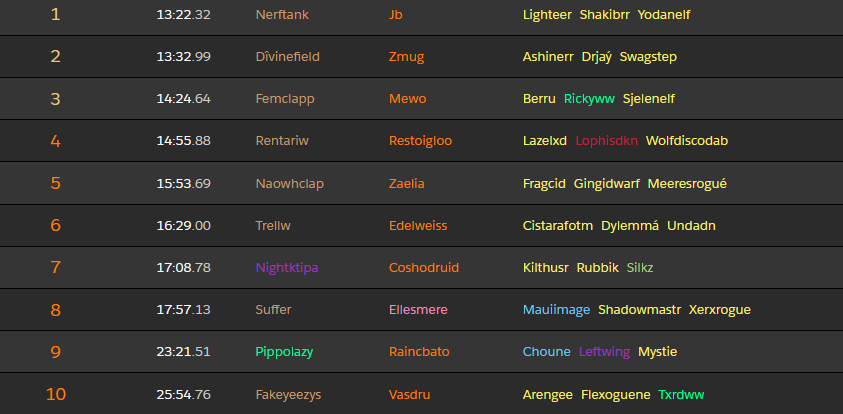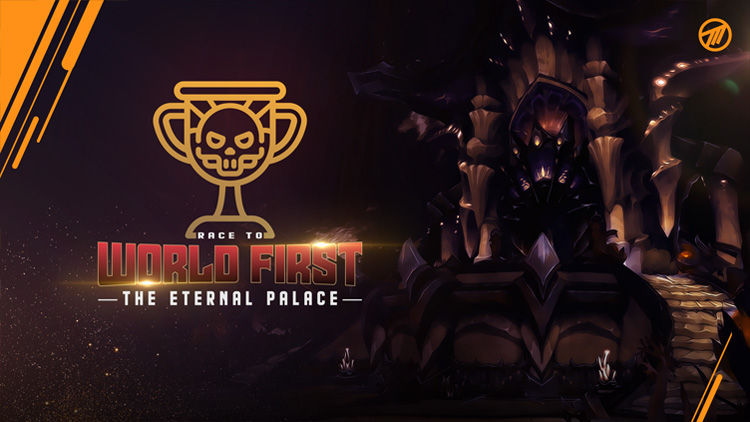This is the second instalment of a three-part series that explores the past, the present, and the future of World of Warcraft esports. Read about the past here.
As we explored in first part of this series, World of Warcraft has had an interesting history with esports. The Arena World Championships (AWC) has been a staple of the scene since the start and remains the cornerstone of the scene to this day. However, in recent years, the Mythic Dungeon International (MDI) has joined the AWC and offered fans an alternative to the player-vs.-player focused esports that most people know of. Instead, it offers fans the chance to watch professional players tackle timed dungeons in a head-to-head battle.
The two other key aspects of World of Warcraftt esports that we’ll touch on in this article are the Race to World First, the streams, the events themselves and what they’ve done for the title. Lastly, we’ll look at the community events, including the Rated Battleground community which has been offering something Blizzard hasn’t in the esports space.
The aim of this article is to provide you will a brief overview of what each of the esports disciplines World of Warcraft is and what makes them different from the others.
AWC: The original, and best?

The AWC is a core element of World of Warcraft esports. In 2019 ,it got the biggest support it’s ever had as Blizzard looked to invest heavily into esports. The AWC is World of Warcraft’s core player-vs.player, three-vs.-three esports. Two groups of three battle it out in a small arena with a number of unique elements, depending on the map, which can change play style and team composition. The AWC enforces a ‘one tank & one healer’ max on compositions, though most tend to use one healer and two DPS. The latter, however, depends heavily on the map, meta, and a variety of other factors.
For the 2019 schedule, the AWC was first split into four regions. North America & Europe featured two full splits made up of six cups and one final per season with five teams advancing from each. The two regions have separate weekend cups but share the same end-of-split finals. Latin America uses an open qualifier system, leading into a round-robin and season final with one side advancing to the AWC finals at BlizzCon. Asia-Pacific follows in the style of Europe and North America by having cups, but they only have the one regional final with one side again advancing. China works in the same way as Asia-Pacific, except it has its own final with one team advancing. Once all of the cups and finals are out the way, the victorious eight sides then headed to BlizzCon for the finals.

The 2019 season also saw Blizzard add in-game store items for players to purchase, increasing the overall prize pool of the 2019 AWC and MDI Grand Final. The two items available were a Transmorpher Beacon – which allowed the user and their group to change into a large selection of World of Warcrafts’s previous dungeon and raid bosses – and a Horde and Alliance theme firework set, which could be used to create a faction-specific firework in-game.
Since originally written, it has now been confirmed that the community provided the entire BlizzCon World of Warcraft prize pool. The toys still remain on the store.
The MDI: PvE esports?

The Mythic Dungeon Invitational is the pinnacle of World of Warcraft player-vs.-environment esports right now, at least officially from Blizzard. The event was first introduced back in 2017 and was similar in 2018, but things started to change in 2019. The event got a slight name change to the Mythic Dungeon International, while keeping the MDI acronym in the process. The event would see a similar seasonal structure as we have seen in the AWC and was also subject to the increased prize pool thanks to the inclusion of the in-game toys.
MDI works in the same way that the ‘Mythic Plus’ system works in live World of Warcraft: players race to finish the objectives before a timer expires, while killing all the bosses on the way. Players are awarded loot based on the speed of completion and the level of the dungeon, with the team’s who complete the keystone in time receiving a new key for another dungeon at a higher level. These affixes would add a range of buffs to instance mobs, from increasing the density of mob packs, spawning pools of healing blood when an enemy was killed, to ones that caused mobs to enrage when hitting 20 percent HP.
MDI has recently given fans the chance to vote on the weekly affix that teams will face if the event goes to a tiebreaker. With the 2019 season now over, Blizzard must continue to improve the format for both players and spectators alike.
?MDI is back and for the first time ever, YOU get to pick the affixes for our wildcard dungeon Atal'Dazar in West Cup #1!
In addition to Tyrannical & Beguiling, which affixes do you want to see the teams tackle this weekend?
?Sat & Sun – https://t.co/nwgNlvoAvT
— World of Warcraft (@Warcraft) August 7, 2019
One of the community’s biggest complaints about MDI in 2019 was been the stale team compositions. With almost every team using one of three compositions, with Warrior Tank, Healing Druid, and at least one Rogue being a staple of each configuration. The worrying news ahead of the latest series is that the situation looks to have gotten worse.
As you can see from the image below, some teams are opting to use upwards of three rogues. Prior to the cup, the Rogue class – more specifically Outlaw – was subject to a number of nerfs. However, apart from a few major roster changes, Rogues continue to be a key factor in MDI. Though, with patch 8.3 and the new Mythic Plus season, Blizzard could be looking to change the scene’s reliance on Rogue by offering the Corrupted affix that allows players to skip section of the dungeon by fighting a mini-boss.

Race to World First: The community event that made it big

The first of our two community-focused esports events comes in the form of the World First Race, otherwise known as the Race to World First. This event has been going on since World of Warcraft raiding began; guilds have always raced each other to down the final boss of whatever the latest raid might be. In 2018, with the release of Battle for Azeroth and the Uldir raid, the Race to World First would change forever.
It all started with a partnership between Method, the leading esports team and top guild, and Red Bull. The partners would host an event out of the Red Bull Gaming Sphere in London, with Red Bull providing commentary for the live stream and a venue for a number of the key Method raiders. The organisation would go on to claim the first place ahead of American guild Limit (who we interviewed just after the event). Method and Red Bull would repeat the partnership for the second raid, Battle of Dazar’alor, and the third raid, Crucible of Storms.
In the most recent raid, the Eternal Palace, however, Method would split from Red Bull and partner with German provider TakeTV whilst Red Bull would also host an event with Limit and Crucible of Storms raid winners Pieces. Method went on to win the race, with Limit claiming a close second.
Outside of BFA, Method also launched an event in partnership with WSOE for the Classic World of Warcraft launch. Method and a team of streamers raced to hit 60 and clear the two raids first. Ultimately, Method was beaten to both goals, but the event offered great coverage of the Classic game and gave fans something different to enjoy.
Moving forward, no one knows what will happen with the Race to World First, though we’ll touch on that more in our final article in this series. What’s clear though is that the streams have been great for the community and have involved more guilds than ever. We’d predict that the event continues, be that community-run again or with official Blizzard involvement.
A star is born?
Community is what drives the early esports scene for a game. At least, it used to. For an esports title to have a long life, the community needs to get behind it. In recent years, we’ve seen an increase in games launching as an esport without any real community to speak of. While a game like Overwatch or Teamfight Tactics can launch and have an esports scene forced upon them, for the long-term health of an esports title you need to build the foundations of a scene; something a strong community allows you to do.
World of Warcraft has a 15-year history, plus an added 10 years for Warcraft as an RTS. Even with that in mind, the title’s esports scene has never captured its core player base in the same way other titles have, partially due to a lack of in-game promotion and connectivity. While in recent years World of Warcraft has embraced its esports scene, the community is still driving to improve aspects of the game that are often forgotten about.
We’ve spoken already about the Race to World First and how that has had a huge impact on World of Warcraft, especially when it comes to Twitch, but another aspect of the community is the Rated Battleground scene. Essentially, it’s a more competitive take on the standard World of Warcraft battlegrounds that we spoke about in the prior instalment. The RBG community is looking to get Blizzard’s attention with another side of World of Warcraft player-vs.-player that has community groups, much like Resurgent Esports Broadcasting which started out hosting its own events and now works with Blizzard to broadcast the Korean AWC in English.
The final current community events come in the form of the Classic Dueler’s League. Right now, Classic has not had its Honour System added, but that’s not stopped a community popping up to support a grassroots esports scene in the form of one-vs.-one duels. The league got underway on October 14th and has been drawing in decently-sized crowds ever since. Blizzard is unlikely to flesh out any official support for Classic World of Warcraft esports, but events such as this just add more layers to an already-loaded esports offering.
Your Classic Dueler's League champions have arrived!!!
Later today, October 14th, at 3:00 P.M. EST, we will be drawing our groups for the CDL Season I Qualifiers! Tune in live at https://t.co/39ahTnOvgI to watch the draw with the community!#wowclassic #community pic.twitter.com/pTiFWiIIJv
— Tips Out (@TipsOut) October 14, 2019
World of Warcraft esports is in a stronger place in 2019 than it’s ever been. With continued support, more community engagement, and continued Twitch growth, the future looks bright.
In the final part of this series, we’ll take a closer look at just that: the future. We’ll see what changes could be made to help engage the player base more, the potential of Blizzard taking control of the World First race, and plenty more.
[maxbutton id=”4″ ]
